Oran
Oran (/ɔːˈrɑːn/, also UK: /əˈrɑːn, əˈræn/, US: /oʊˈrɑːn, oʊˈræn, ɔːˈrɒ̃/,[2][3][4][5] French: [ɔʁɑ̃]; Arabic: وَهران, romanized: Wahrān) is a major coastal city located in the north-west of Algeria. It is considered the second most important city of Algeria after the capital Algiers, due to its commercial, industrial, and cultural importance. It is 432 km (268 mi) from Algiers. The total population of the city was 759,645 in 2008,[6] while the metropolitan area has a population of approximately 1,500,000[7] making it the second largest city in Algeria.[8]
Oran وهران | |
|---|---|
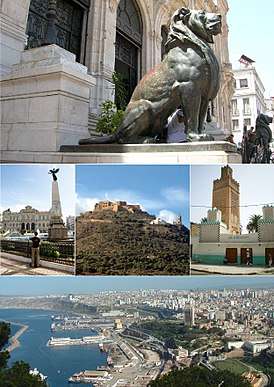 Top, the two Lions of Atlas (symbol of Oran), Center, 1st November Place, fort & chapel of Santa Cruz, Bey Othmane mosque, Bottom, general view | |
 Seal | |
| Nickname(s): The radiant " الباهية " | |
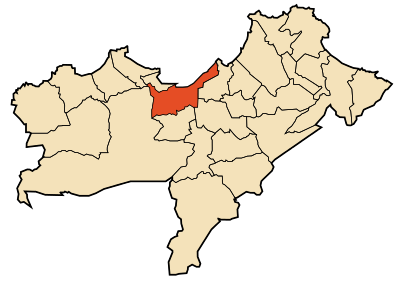 | |
 Oran Location within Algeria  Oran Oran (Africa) | |
| Coordinates: 35°41′49″N 0°37′59″W | |
| Country | |
| Province | Oran Province |
| District | Oran District |
| Re-founded | AD 944 |
| Government | |
| • Wali (Governor) | Saddek Benkada |
| Area | |
| • City | 2,121 km2 (819 sq mi) |
| Elevation | 0.9 m (3 ft) |
| Population (2008 for city proper, 2010 for metro area)[1] | |
| • City | 1,560,329 |
| • Metro | 3,454,078 |
| Time zone | UTC+1 (CET) |
| Postal codes | 31000 - 31037 |
A legend says that in 900 CE, lions still lived in the area. The last two lions were hunted on a mountain near Oran and are elsewhere referred to as "mountain lions".[9]
Etymology
The word derives from the Berber root hr, meaning lion (see also Tiaret and Souk Ahras). The name is attested in multiple Berber languages, for instance as uharu and ahra. A locally popular legend tells that in the period around 900 CE, there were sightings of lions in the area. The two last lions were killed on a mountain near Oran, and it became known as La montagne des lions ("The Mountain of Lions"). Two giant lion statues stand in front of Oran's city hall, symbolizing the city.
History
- See also: Timeline of Oran and History of Oran (fr)
Overview
During the Roman empire, a small settlement called Unica Colonia existed in the area of current Oran, but this settlement disappeared after the Arab regain of the Maghreb.
Present-day Oran was founded in 903 by Moorish Andalusi traders.[10] It was captured by the Castilians under Cardinal Cisneros in 1509, and Spanish sovereignty lasted until 1708, when the city was conquered by the Ottomans. Spain recaptured the city in 1732. However, its value as a trading post had decreased greatly, so King Charles IV sold the city to the Turks in 1792. Ottoman rule lasted until 1831, when the city fell to the French.
Under French rule during the 19th and 20th centuries, Oran was the capital of a département of the same name (number 92). In July 1940, the British navy shelled French warships in the port after they refused a British ultimatum to surrender; this action was taken to ensure the fleet would not fall into German hands, as the Nazis had defeated France and occupied Paris. The action increased the hatred of the Vichy regime for Britain but convinced the world that the British would fight on alone against Nazi Germany and its allies. The Vichy government held Oran during World War II until its capture by the Allies in late 1942, during Operation Torch.
Also, during French rule, Jews were encouraged to modernize and take on jobs they had not before including agriculture. Jews In the city were allowed to join the French Army starting October 24, 1870 when Algerian Jews were granted citizenship. French Jews would soon be targeted after not choosing to side with the Algerian Muslims who fought for independence against France.[11]
Before the Algerian War, 1954–1962, Oran had one of the highest proportions of Europeans of any city in North Africa. In July 1962, after a ceasefire and accords with France, the FLN entered Oran and were shot at by a European. A mob attacked pied-noir neighborhoods in response to the attack and massacred thousands of Europeans in Oran;[12] 453 have been said to have "disappeared."[13] This triggered a larger exodus of Europeans to France, which was already underway. Shortly after the end of the war, most of the Europeans and Algerian Jews living in Oran fled to France. In less than three months, Oran lost about half its population. This population loss is similar to the Jews as many fled after siding with France in the Algerian War for Independence. As the war progressed, those who supported independence in Algeria threatened those who sided with Europe causing these people to flee and thus defeating European imperialism.[11]
Religious history
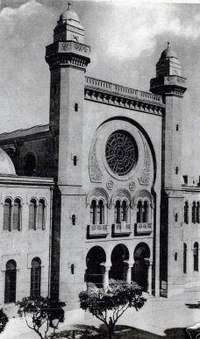
With its location as the closest port to Spain and its prominence on the Mediterranean, Jewish refugees first immigrated to Oran to flee persecution and conversion to Christianity in Spain in 1391. This refuge brought other religious refugees that included both Jews again and Muslims in both 1492 and 1502. On October 24, 1870, with the French dominance, Algerian Jews were given French citizenship with the Cremieux Decree. Later, despite a World War II sentiment that favored acceptance, Oran still had a history marked by intolerance. There was a decrease in the Jewish population as Muslims were the only group granted citizenship protection in 1963, one year after Algerian independence.[14]
Islamic dynasties (910–1509)
| Start year | End year | Event |
|---|---|---|
| 910 | 1082 | Oran became a perpetual object of conflict between the Umayyads of al-Andalus and the Fatimids of Kairouan. |
| 1082 | 1145 | Presence of Almoravids. In 1145, Tashfin ibn Ali perished in the outskirts of Oran while trying to flee the besieging Almohad troops, who had already captured Tlemcen, and defeated the Zenata. |
| 1145 | 1238 | Presence of Almohads. 1147 marked the beginning of a period of persecution of Oran's Jews. |
| 1238 | 1509 | Presence of the Zianides of Tlemcen and then the Marinid dynasty of Fes. The Oranians grew rich from protection by the Emir, the customs system (tariffs), trade with Marseilles, and the Italian Maritime Republics of Genoa and Venice, with whom, in 1250, Oran signed a commercial treaty for 40 years. Toward the end of the 14th century, celebrated Arab historian Ibn Khaldoun wrote, "Oran is superior to all other cities by its trade. It's a paradise for the unhappy one. Those who arrive poor in its walls, will leave it again rich." The city excelled in the export of lead, wool, skins, fine burnous, carpets, haïks, cumin, nuts, and galls, as well as black African slaves. |
Spanish period (1509–1708, 1732–1792)
Before the Spaniards, the Portuguese launched a failed expedition to capture the city in July 1501. Four years later, the Spanish took Mers-el-Kébir, located just four miles (6.4 km) to the west of the Oran. Thus began the first organized incursions against the city which, at the time, numbered 25,000 inhabitants and counted 6,000 fueros. Count Pedro Navarro, on the orders of Cardinal Francisco Jiménez de Cisneros, finally captured the city on May 17, 1509. The occupying forces set fire to the books and archives of the town.[15]
By 1554, the Turks had reached Algiers. The governor of Oran, Count Alcaudete, allied himself with Moroccan Sultan Mohammed ash-Sheikh against them. Nine years later, in 1563, Álvaro de Bazán, Marquis de Santa Cruz, built the fort of Santa-Cruz, strategically placed at the top of a mountain, l'Aïdour, more than 1,000 ft (300 m) above the sea, directly to the west of the city. Pedro Garcerán de Borja, Grand Master of the Order of Montesa, was captain of Oran when, on July 14, 1568, John of Austria (the illegitimate son of Charles I and paternal half-brother of King Philip II), led a flotilla of 33 galleys against the Algerians.
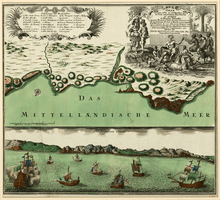
In April 1669 the Spanish governor, the Marquis of Los Vélez, expelled all the Jews who lived in Oran and Mers El Kébir[16] sending them to be resettled in either Nice, or Livorno.
The Spanish rebuilt Santa Cruz Fort to accommodate their city governors. "The fortifications of the place were composed of thick and continuous walls of over two and a half km in circumference, surmounted by strong towers spaced between them," with a central castle or kasbah where the Spanish governor had his headquarters. Under Spanish rule, the city continued to grow, requiring enlargement of the city walls. In spite of the improved fortifications, the city was the object of repeated attacks. Notable in this regard, Moroccan Sharif Moulay Ismail tried to force his way past the defences in 1707, only to see his army decimated.
Ottoman period (1708–1732, 1792–1831)

The Spanish occupied the city until 1708, when the Turkish Bey, Mustapha Ben Youssef (Bouchelaghem) took advantage of the War of Spanish Succession to drive them out.
In 1732, Spanish forces returned under José Carrillo de Albornoz, capturing the city from Bey Hassan. Spain maintained its hold over Oran for the next six decades.
In the night after October 8, 1790, a violent earthquake claimed more than 3,000 victims in less than seven minutes. Charles IV saw no advantage in continuing the occupation of the city, which had become increasingly expensive and perilous. He initiated discussions with the Bey of Algiers. They signed a treaty on September 12, 1792 by which the Spanish transferred the city to the Ottoman Empire. After another earthquake damaged the Spanish defences, the forces of the Ottoman ruler of Algiers, Muhammad Bey (Muhammad Ben-Othman, or Muhammad Bey "el-Kebir"), took possession of Oran on October 8 of the same year. In 1792, the Ottomans settled a Jewish community there. In 1796, the Pasha Mosque (in honour of Hassan Pasha, Dey of Algiers) was built by the Turks with ransom money paid for the release of Spanish prisoners after Spain's final departure. In 1830 the Beys moved their Algerian capital from Mascara to Oran.
French period (1831–1962)
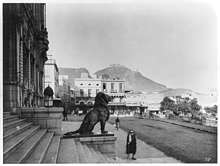
The town of 10,000 inhabitants was still in the possession of the Ottoman Empire when a squadron under the command of captain Bourmand seized el-Kébir on December 14, 1830. The city was in a wretched state. On January 4, 1831, the French commanded by General Damrémont occupied Oran. In September 1831, General Berthezène appointed Mr. Pujol as mayor of Oran; he had been captain of cavalry in retirement and was wounded in the right hand under the Empire.
In 1832, leading a force of five thousand men, the young Emir Abd al-Qadir attacked Oran. In April 1833, commander-in-chief, General Boyer, was replaced by the baron Louis Alexis Desmichels. The city's defenders, under attack by Abd al Qadir, held their ground .
In World War II, Oran was one of the landing points in Operation Torch, the first American action in the Europe-North Africa theatre in November 1942. The Task Force suffered some damage to its fleet, trying to land in shallow water, but the enemy ships were sunk or driven off, and Oran surrendered after heavy fire from British battleships.[17]
Since independence (1962)
Due to the exodus of Pieds-Noirs, the Cathédrale du Sacré-Cœur d'Oran was converted into a public library in 1984.[18]
Today, Oran is a major port and a commercial centre, and has three universities. The old quarter of Oran has a casbah and an 18th-century mosque. The modern section of Oran is referred to as La Ville Nouvelle and was built after 1831; this section contrasts with the older section, La Blanca.[19]
Geography
Climate

Oran features a semi-arid climate (Köppen climate classification BSk/BSh). Oran's climate does show influences of a Mediterranean climate; however the combination of the city's relatively high average annual temperature and relatively low annual precipitation precludes it from falling under that climate category. Oran averages 326 mm (13 in) of precipitation annually, the bulk of which falls between November and May. Summers are the warmest times of the year, with average high temperatures in the warmest month (August) approaching 32 degrees Celsius. Winters are the coolest times of the year in Oran, with high temperatures in the coolest month (January) at around 17 degrees Celsius.
| Climate data for Oran | |||||||||||||
|---|---|---|---|---|---|---|---|---|---|---|---|---|---|
| Month | Jan | Feb | Mar | Apr | May | Jun | Jul | Aug | Sep | Oct | Nov | Dec | Year |
| Record high °C (°F) | 26.4 (79.5) |
33.0 (91.4) |
36.6 (97.9) |
33.2 (91.8) |
40.0 (104.0) |
39.5 (103.1) |
45.8 (114.4) |
43.8 (110.8) |
40.6 (105.1) |
39.0 (102.2) |
33.0 (91.4) |
30.8 (87.4) |
45.8 (114.4) |
| Average high °C (°F) | 16.6 (61.9) |
17.7 (63.9) |
19.7 (67.5) |
21.5 (70.7) |
23.9 (75.0) |
27.7 (81.9) |
30.5 (86.9) |
31.6 (88.9) |
29.0 (84.2) |
25.2 (77.4) |
20.6 (69.1) |
17.7 (63.9) |
23.5 (74.3) |
| Daily mean °C (°F) | 10.9 (51.6) |
12.1 (53.8) |
13.9 (57.0) |
15.8 (60.4) |
18.6 (65.5) |
22.3 (72.1) |
25.0 (77.0) |
25.9 (78.6) |
23.4 (74.1) |
19.6 (67.3) |
15.1 (59.2) |
12.2 (54.0) |
17.9 (64.2) |
| Average low °C (°F) | 5.1 (41.2) |
6.5 (43.7) |
8.1 (46.6) |
10.0 (50.0) |
13.2 (55.8) |
16.9 (62.4) |
19.4 (66.9) |
20.1 (68.2) |
17.7 (63.9) |
14.0 (57.2) |
9.5 (49.1) |
6.7 (44.1) |
12.3 (54.1) |
| Record low °C (°F) | −3.0 (26.6) |
−3.0 (26.6) |
−1.3 (29.7) |
0.0 (32.0) |
3.0 (37.4) |
5.0 (41.0) |
11.0 (51.8) |
9.0 (48.2) |
7.7 (45.9) |
3.0 (37.4) |
0.0 (32.0) |
−6.1 (21.0) |
−6.1 (21.0) |
| Average precipitation mm (inches) | 43.6 (1.72) |
44.4 (1.75) |
35.0 (1.38) |
29.6 (1.17) |
27.2 (1.07) |
3.8 (0.15) |
1.8 (0.07) |
2.7 (0.11) |
13.2 (0.52) |
24.8 (0.98) |
55.5 (2.19) |
45.2 (1.78) |
326.8 (12.87) |
| Average precipitation days (≥ 0.1 mm) | 8.7 | 8.5 | 7.1 | 7.2 | 6.9 | 2.0 | 1.3 | 1.8 | 3.6 | 6.6 | 8.4 | 8.8 | 70.9 |
| Average relative humidity (%) | 79.5 | 76.5 | 74.0 | 70.0 | 68.0 | 66.2 | 64.7 | 66.5 | 70.2 | 73.9 | 76.3 | 78.6 | 72.0 |
| Source 1: World Meteorological Organization (UN)[20] | |||||||||||||
| Source 2: climatebase.ru (extremes, humidity)[21] | |||||||||||||
Earthquakes
As Oran is located in Northern Algeria, it faces the constant threat of earthquakes that can cause damage to the city. The last major earthquake was in 1790 which killed 3,000 people. Many of the existing older buildings in the city have been reinforced and newer construction is made to withstand earthquakes from the start. While the city dates back to the 900s, the oldest remaining buildings are from the French period in the 1800s making it easier to reinforce these buildings.[22]
Government
City districts
List of districts of Oran

| District | Arabic name | Name |
|---|---|---|
| 1 | الحمري | El Hamri |
| 2 | حي الإمام الهواري | Hai Imam El-Houari |
| 3 | السعادة | Es-Saada |
| 4 | المقري | Al-Maqarri |
| 5 | الحمري | El-Hamri |
| 6 | البدر | El-Badr |
| 7 | الصديقية | Es-Seddikia |
| 8 | المنزه | El-Menzeh |
| 9 | الأمير | El-Emir |
| 10 | العثمانية | El-Othmania |
| 11 | بوعمامة | Bouamama |
| 12 | محي الدين | Muhieddine |
Medina Jedida
Medina Jedida or, new city in English, is a large historical and popular district. It was one of the Muslim quarters in the French colonial period. In this district, there is one of the biggest markets in the country, called Le Marché de Medina Jedida (Medina Jedida Market).
El Hamri

El Hamri is a large and popular district in the center of Oran, known under French rule as Lamur. The football club Mouloudia d'Oran is found there.
Neighborhood streets
- Avenue of Lamur
- Street Captain-Rahou
- Sebbalet Ayada
- Place The Sahara
- Gahwat Ettoubi
- Street Staoueli
- Street Djemaa Gazouna
- Street Bougandoura
- Street Belhadri Smain
Sidi El Houari
The historical district Sidi El Houari is a suburb in the north of the d'Oran city. The Saint-Louis college is there, as well as the old mosque of the Pasha dating from the 17th century. In this district the skin of Saint-Patron of the city in the name of "Sidi El Houari" rests. Other tourist curiosities: one ancient prefecture of the data base Stalingrad, the Spanish vestiges dating from the 16th century, and especially the Palate of the Bey d'Oran.
Oranian agglomeration


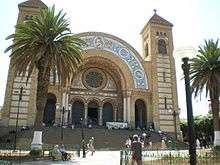
The Oranian metropolis comprises several communes.(fr)

Mers El-Kébir
Mers El Kébir is a municipality located in north-west of Oran, about seven km (4.3 miles) from the city centre. As its name indicates (The Great Port), it is a major port and has an important naval base, home to the Algerian Navy.
Aïn El-Turk
Aïn El Turk, whose name means Fountain of the Turks is also located at the North-West of Oran to 15 km (9 mi) of the center. It is a seaside town which includes several hotels and other tourist attractions.
Es-Sénia
Es Sénia, located in the south of Oran, is home to industrial parks, several university institutes (Oran-Es-Sénia University, Institut of Communication, ENSET "Higher Teacher training school," CRASC "Research center in social sciences," etc.) and the international airport.
Bir El-Djir
Bir El Djir is a commune that represents the suburbs of Oran (apart from the districts). It is the future beating heart of the Oranian agglomeration. It has several buildings which are the seats of institutions as the headquarters of Sonatrach's downstream activity, the hospital Etablissement Hospitalo-universitaire "November 1st, 1954", the convention center (Palais des Congrès), University of sciences and technology (conceived by the Japanese architect Kenzō Tange), the Institute of medical sciences, the Court of Justice and the National Centre of Research in Social and Cultural Anthropology. There is as well a stadium with a capacity of 50000 places under construction.
Bir El Djir is the urban extension to the East of Oran, 8 km (5 mi) far from the city center, with a population of 118.000 inhabitants.
Misserghin
Misserghin is a small city located to the southwest of Oran.
Transportation
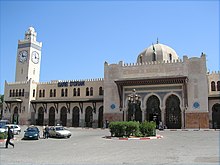
The city's public transportation is centered on the Oran Metro covering coastal neighborhoods with the connecting Oran tramway covering suburbs not yet served by the metro. There is an extensive network of "clandestine" taxis in the City. A project started in 2008/9 and lasted approximately two to three years, to deliver the first line of the tramway in 2010. It should comprise 31 stations, distributed on 17.7 km (11 mi) going to Es-Sénia, in the South and Sidi Maarouf in the east side, while passing by the centre town The tramway should serve Haï Sabbah, University of Sciences and Technology (USTO), the Crossroads of the Three Private clinics, the Law courts, Dar El Baïda, the Plate-Saint Michel, the Place of the 1st November, Saint-Anthony, Boulanger, Saint-Hubert, the 3rd Ring road and finally The University of Es-Sénia. The Ahmed Ben Bella Airport, for domestic and international flights. Oran Es Senia Airport serves both, domestic and international flights, with frequent connections to the capital Algiers, served by the public airline company Air Algerie. The same company also has flights to many French cities (Marseille, Paris, Lyon, etc.) and other European and EMEA cities. The Es Senia Airport also serves passengers from most smaller towns in proximity to Oran (Sig, Mostaganem, Arzew, etc.). The airport building is a fairly limited construction and does not operate on a 24-h basis.
Sports
International marathon
Oran held its first international marathon on November 10, 2005. The event, sponsored by Toyota of Algeria, attracted runners from Morocco, Libya, Spain, France, and Kenya. The marathon served to publicize the health benefits of running and to provide a novel form of public entertainment for the city's residents.
2021 Mediterranean Games
XIX Mediterranean Games will be held in Oran in 2021.
Culture
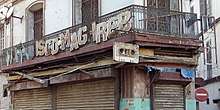
The folk music Raï ("opinion" in Arabic), had its beginnings in Oran. This genre of music was formulated by shepherds in the 1930s through Arab and European influences. This music was surrounded by controversy due to women's key role in public performances of the music, as well as the hedonistic lyrics about love and alcohol. This led to strict governmental control in the area which led to arrests, injuries, and assassinations.[23] Many notable Raï musicians (including Cheb Hasni, Cheb Khaled, and Rachid Taha) hail from Oran. The violinist Akim el Sikameya was also born in Oran. One of Oran's most famous emigrants is Yves Saint Laurent.[24]
Representation in other media
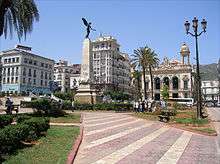
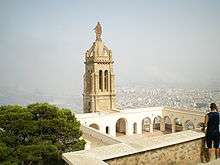
- Albert Camus' essay The Minotaur describes life in Oran.
- Albert Camus' 1947 novel The Plague presents a fictional tale of observations of a physician during the emergence and recession of bubonic plague in the 1940s in Oran.
- El Gallardo Español (1615) by Miguel de Cervantes takes place in Oran.
- In the movie Casablanca (1942), the route for refugees fleeing to the Americas was Paris to Marseille, across the Mediterranean to Oran, then by train, auto or foot to Casablanca. If they acquired an exit visa, they went on to Lisbon from there.
- Paul Bowles' 1949 novel The Sheltering Sky mainly takes place in Oran.
- Part of Arturo Pérez-Reverte's Capitán Alatriste adventure novel, Corsarios de Levante (Pirates of the Levant, 2006), takes place in early 17th-century Oran. The action of the book occurs a few years after the forced expulsion of the last Moriscos (Spanish Christians of Muslim descent) from Valencia. Oran is featured as a sun-blasted North African military stronghold. Capitán Diego Alatriste finds Oran to be manned by an impoverished garrison of Spanish Christians, living alongside Muslims (some fiercely loyal to Spain), and Sephardic Jews, descendants of refugees from the 1492 expulsions from Spain.
- In the ITV drama series Hornblower, Lieutenant Hornblower is sent by Captain Pellew to Oran to obtain supplies, only to discover that the city was suffering from a bubonic plague epidemic.
- The heroine of Geraldine Brooks' novel, Year of Wonders, emigrates to Oran after leaving her home village that was quarantined in 1666 due to the plague.
- Joann Sfar's graphic novel The Rabbi's Cat 2 begins in Oran.
- Kamel Daoud's novel The Meursault Investigation is set in a bar in Oran.[25]
Economy and infrastructure
- See also: Economy of Oran (fr)
Oran has become a major trading centre for the wider area, serving Arzew, the area's oil/gas port as well as Sonatrach, the country's biggest oil and gas company. Sonalgas has built a new congress centre in Oran and in 2010 the 16th International Conference & Exhibition on Liquefied Natural Gas was held in the city of Oran, which attracted around 3,000 visitors and major companies from around the world. To accommodate all visitors, new hotels are currently being constructed and floating hotels will be used in the future. With a growth in urbanization, water quality and management is being harmed in Oran; this change in water quality is affecting marine life and the state of beaches in this tourism driven city.[26]
Tourism
Oran has numerous hotels in all categories, from luxury to basic, as well as many restaurants offering Algerian specialities and other foods. Tourists will also find a variety of cinemas, arts centres, the regional theatre, an open-air theatre, the Museum, the historic city centre of Oran, the district of Sidi El Houari, the municipal gardens, Médina Djedida with its artisanal products, the cathedral, Djebel Murdjadjo, and nearby seaside resorts. Ahmed Ben Bella Airport is 7.4 mi (11.9 km) from the town centre. One can also reach Oran by ferries from the ports of Marseilles, Sète, Alicante and Almería, via the national company Algérie Ferries. The Great Mosque is another attraction for tourists. The Great Mosque was built in 1796 to celebrate the end of Spanish Rule of the City.[27]
Attractions
The main museum in Oran is called Musée National Ahmend Zabana. Although often overlooked by tourists, it includes a natural history exhibit in addition to arts pieces like mosaics and portraits.[24] Bey's Palace is another favorite spot for tourists, situated in Sidi al-Houari in the city center. It is an Ottoman era palace built of Islamic architecture, consists of harem, guard towers and stucco-painted halls.[28]
International relations
Oran is twinned with:
Partnerships and cooperation
Notable residents
- Khaled (born 1960), prominent Raï singer and multi-instrumentalist
- Armand Mouyal (1925–88), French world champion épée fencer, born in Oran
- Baghdad Bounedjah (born 1991), footballer
- Yves Saint Laurent (1936–2008), French fashion designer, born in Oran
References
- "Algeria: The provinces of the People's Democratic Republic of Algeria as well as all cities of over 25,000 inhabitants". CITYPOPULATION. Archived from the original on 2014-08-17. Retrieved 2014-05-12.
- "Oran". The American Heritage Dictionary of the English Language (5th ed.). Boston: Houghton Mifflin Harcourt. Retrieved 15 April 2019.
- "Oran". Collins English Dictionary. HarperCollins. Archived from the original on 15 April 2019. Retrieved 15 April 2019.
- "Oran" Archived 2019-04-15 at the Wayback Machine (US) and "Oran". Oxford Dictionaries UK Dictionary. Oxford University Press. Retrieved 15 April 2019.
- "Oran". Merriam-Webster Dictionary. Retrieved 15 April 2019.
- "The provinces of Algeria and all cities of over 25,000 inhabitants". Citypopulation.de. Archived from the original on 2014-08-17. Retrieved 2008-04-14.
- Messahel, Abdellah (1 June 2008). "Une périurbanisation officielle dans un site contraignant". Espace Populations Sociétés. Space Populations Societies (2008/1): 89–99. doi:10.4000/eps.2408. Archived from the original on 27 May 2013. Retrieved 23 June 2018.
- About Oran Archived 2008-01-29 at the Wayback Machine—from the city's website.
- "Oran-dz". Oran-dz.com. Archived from the original on 2014-12-23. Retrieved 2015-01-21.
- "The Jewish Community of Oran, Algeria | Beit Hatfutsot". Beit Hatfutsot. Archived from the original on 2018-06-12. Retrieved 2018-06-11.
- "Oran". Jewish Virtual Library. Archived from the original on 2016-11-13.
- Benjamin Stora, Algeria, 1830–2000: A Short History (Cornell University Press, 2004) p105
- Thiolay, Boris (2006-09-13). "Algérie 1962 : La vérité sur les massacres d'Oran". L'Express. Archived from the original on 13 August 2012. Retrieved 12 November 2012.
- "The Jewish Community of Oran, Algeria | Beit Hatfutsot". The Museum of the Jewish People at Beit Hatfutsot. Archived from the original on 2018-06-12. Retrieved 2016-11-14.
- Urzainqui, Tomas; Esarte, Pello; García Manzanal, Alberto; Sagredo, Iñaki; Sagredo, Iñaki; Sagredo, Iñaki; Del Castillo, Eneko; Monjo, Emilio; Ruiz de Pablos, Francisco; Guerra Viscarret, Pello; Lartiga, Halip; Lavin, Josu; Ercilla, Manuel (2013). La Conquista de Navarra y la Reforma Europea. Pamplona-Iruña: Pamiela. ISBN 978-84-7681-803-9.
- Jonathan Israel (1994). "The Jews of Spanish Oran and Their Expulsion in 1669". Mediterranean Historical Review. 9 (2): 235–255. doi:10.1080/09518969408569672.
- Rohwer & Hummelchen 1992 p. 175.
- "Cathédrale de Sacré Coeur". Visit Oran. Archived from the original on 2016-11-09. Retrieved 2016-11-09.
- "Oran | Algeria". Encyclopædia Britannica. Archived from the original on 2016-11-14. Retrieved 2016-11-14.
- "Weather Information for Oran". Worldweather.org. Archived from the original on 2011-01-04.
- "Oran, Algeria". Climatebase.ru. Archived from the original on 2 May 2013. Retrieved 11 February 2013.
- "Earthquakes In Algeria" (PDF). Archived (PDF) from the original on 2016-11-09.
- Joan, Gross (2002). Jonathan Xavier and Renato Rosaldo (ed.). "Arab Noise and Ramadan Nights: Rai, Rap and Franco-Maghrebi Identities" The Anthology of Globalization: A Reader. Oxford: Blackwell.
- "Oran". Lonely Planet. Archived from the original on 2016-11-14. Retrieved 2016-11-14.
- Lalami, Laila (2015-06-08). "'The Meursault Investigation,' by Kamel Daoud". The New York Times. Archived from the original on 12 June 2015. Retrieved 10 January 2016.
- Tayeb A, Chellali M, Hamou A, Debbah S (2015). "Impact of urban and industrial effluents on the coastal marine environment in Oran, Algeria". Marine Pollution Bulletin. 98 (1–2): 281–288. doi:10.1016/j.marpolbul.2015.07.013. PMID 26164780.
- "Great Mosque". Visit Oran. Archived from the original on 2016-11-09. Retrieved 2016-11-09.
- قصر الباي بوهران ..عانق تاريخ العثمانيين ليبكي على الأطلال اليوم Archived 2018-01-10 at the Wayback Machine. Djazairess. Retrieved January 10, 2018.
- "Bordeaux – Rayonnement européen et mondial". Mairie de Bordeaux (in French). Archived from the original on 2013-02-07. Retrieved 2013-07-29.
- "Bordeaux-Atlas français de la coopération décentralisée et des autres actions extérieures". Délégation pour l’Action Extérieure des Collectivités Territoriales (Ministère des Affaires étrangères) (in French). Archived from the original on 2013-02-07. Retrieved 2013-07-29.
- "Sister Cities Home Page". Archived from the original on October 11, 2012. eThekwini Online: The Official Site of the City of Durban
- "VILLE PARTENAIRE ET SOLIDAIRE". Ville de Strasbourg (in French). Retrieved 2019-10-10.
Bibliography
External links
| Wikivoyage has a travel guide for Oran. |
| Wikisource has the text of the 1911 Encyclopædia Britannica article Oran. |
- EasyOran—(in French) The Oran electronic guide
- Visit Oran—Voted in 2007 as "Oran's best website" by the ministry of culture and Panoramic Tours. Mostly dedicated to tourism. Features photo galleries, short films, news, city guides & information, hotel info & reservation forms, forum...
- Le Souk d'Oran—Oran student's community
- Oran's Community FORUM—The Community Discussion Forum for Oran and tourism.
- (in English) Audio interview with Oran resident about life in Oran.
- Oran MAPS—Detailed maps of the Oran Region and City.
- (in French) Oran-dz
| Wikimedia Commons has media related to Oran. |

.svg.png)